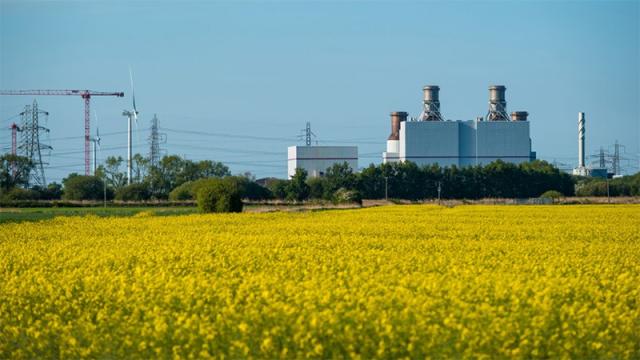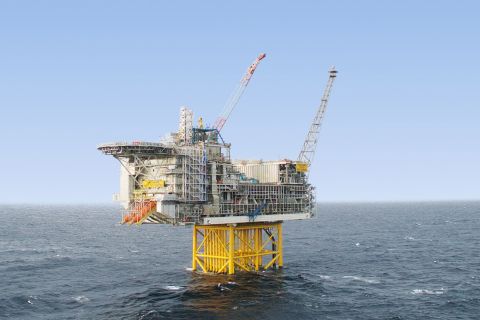
The Keadby 1 power station. (Source: Stuart Nicol/SSE Thermal)
Equinor and SSE Thermal unveiled plans April 8 to jointly develop two first-of-a-kind, low-carbon power stations in the U.K.’s Humber region, comprising one of the U.K.’s first power stations with carbon capture and storage (CCS) technology, and the world’s first 100% hydrogen-fueled power station.
The plans, underpinned by a new cooperation agreement between the two companies, would support the UK’s transition to net zero and accelerate the decarbonization of the Humber, the UK’s largest and most carbon-intensive industrial cluster. The projects have the potential to create thousands of skilled jobs and revitalize a key industrial heartland.
The two decarbonized power stations, which would form a “clean power hub” near Scunthorpe, North Lincolnshire, would be among the first in the world to utilize CCS and hydrogen technologies. Keadby 3 and Keadby Hydrogen would replace older, carbon-intensive generation on the electricity grid, providing flexible and efficient power to support intermittent renewable generation and maintain security of supply through the net zero transition.
These projects would also result in the Humber making a significant contribution to the U.K.’s 2030 targets for CCS and hydrogen. Keadby 3 could deliver 15% of the target for 10MT of carbon captured annually by 2030, while the demand from Keadby Hydrogen could account for a third of the 5GW hydrogen production goal.
North Sea Storage
Keadby 3 would be a 900 MW power station fueled by natural gas and fitted with carbon capture technology to remove the CO2 from its emissions. The captured CO2 would then be transported using shared pipelines before being securely stored under the Southern North Sea. A formal consultation for Keadby 3 concluded in early 2021 and the project is currently progressing toward the submission of a development consent application in Spring 2021. Keadby 3 would have the potential to come online by 2027, in line with government ambitions for “Track 1” industrial cluster projects.
Keadby Hydrogen power station would have a peak demand of 1,800MW of hydrogen, producing zero emissions at the point of combustion. It would be the world’s first major 100% hydrogen-fired power station, securing at-scale demand for hydrogen in the region for decades to come. With appropriate policy mechanisms in place, Keadby Hydrogen could come online before the end of the decade.
The Keadby 3 and Keadby Hydrogen projects are both in the development stage and the companies will continue to engage government, regulators and stakeholders. Final investment decisions will depend on the progress of policy frameworks that are commensurate with the delivery of this critical net zero enabling infrastructure.
The projects would utilize the parallel hydrogen and CO2 pipeline infrastructure being developed by the Zero Carbon Humber (ZCH) partnership—which includes Equinor and SSE Thermal—and offshore CO2 infrastructure developed by the six-member Northern Endurance Partnership (NEP), which includes Equinor. Both ZCH and NEP won public funding from the U.K.’s Industrial Strategy Challenge Fund in March.
Equinor’s H2H Saltend project will be the first to connect into the ZCH infrastructure and will come online by the mid-2020s. Like the additional hydrogen that would be produced for the Keadby Hydrogen project, H2H Saltend will provide low-carbon hydrogen to already-identified customers.
Hydrogen Blending Options
As part of the agreement, SSE Thermal and Equinor are also developing options for hydrogen blending at SSE Thermal’s Keadby 2 project (already under construction), aiming to progressively decarbonize the UK’s newest and most-efficient power station. The companies also have the intention to collaborate on projects elsewhere in the UK.
The agreement builds on the longstanding partnership between Equinor and SSE in the U.K., which includes joint ownership of the Aldbrough Gas Storage facility in East Yorkshire, and the joint venture to build the Dogger Bank Offshore Wind Farm, the largest offshore wind farm in the world.
Kwasi Kwarteng, Secretary of State for Business, Energy and Industrial Strategy, said:
“The Humber region is at the heart of our commitment to tackle climate change and is already on the frontline of developing vital clean technologies which will change the way people’s homes and businesses are powered while slashing emissions. This new partnership will ensure that world-first technology is being developed in Scunthorpe and across the Humber, creating green jobs and bringing new investment which will benefit local communities and businesses—revitalizing this industrial heartland as the U.K. builds back greener.”
Stephen Wheeler, Managing Director of SSE Thermal, said:
“We’re delighted to be announcing this agreement with Equinor through which we aim to develop these first-of-a-kind low-carbon power stations. These projects would play a major role in decarbonizing the U.K.’s flexible generation capacity, while supporting a green economic recovery in the Humber. By utilizing cutting-edge carbon capture and hydrogen solutions, we can decarbonize power generation, heavy industry and hard-to-reach sectors of the economy, which will be essential in both achieving net zero emissions and ensuring a just transition for workers and communities. With over 12 million tonnes of annual carbon emissions, ideal transport and storage options, and major energy and industrial companies working together, the Humber has to be at the center of the U.K.’s decarbonization strategy.”
Grete Tveit, Senior Vice President for Low Carbon Solutions at Equinor, said:
“We are very happy that Equinor and SSE are building on our long-term energy partnership to also develop low-carbon projects together in the UK. These world-leading power plants at Keadby will accelerate efforts across the Humber to create a decarbonized industrial cluster, and contribute to the UK’s goals for a green industrial revolution and reaching net zero. They are a further step in Equinor’s ambitions for the Humber, following on from our H2H Saltend project that will start producing low-carbon hydrogen at scale by the mid-2020s. We believe these technologies are vital for heavy industry, flexible power and other hard-to-abate sectors to achieve net zero emissions, while also ensuring a just transition for industrial communities. We are committed to working together with stakeholders to accelerate these real-life projects and make these investments happen.”
Recommended Reading
NOD Approves Start-up for Aker BP’s Hanz Project
2024-02-27 - Aker BP expects production on the North Sea subsea tieback to begin production during the first quarter.
OKEA Fast-tracking North Sea’s Brasse Tieback to Brage
2024-04-08 - OKEA expects first production in 2027 and has signed contracts with Aker Solutions, Subsea7 and OneSubsea.
E&P Highlights: March 4, 2024
2024-03-04 - Here’s a roundup of the latest E&P headlines, including a reserves update and new contract awards.
Deepwater Roundup 2024: Americas
2024-04-23 - The final part of Hart Energy E&P’s Deepwater Roundup focuses on projects coming online in the Americas from 2023 until the end of the decade.
Vår Energi Hits Oil with Ringhorne North
2024-04-17 - Vår Energi’s North Sea discovery de-risks drilling prospects in the area and could be tied back to Balder area infrastructure.




